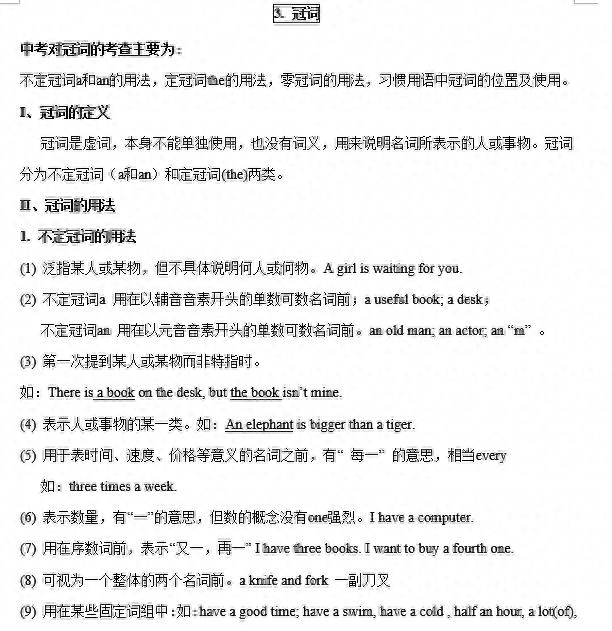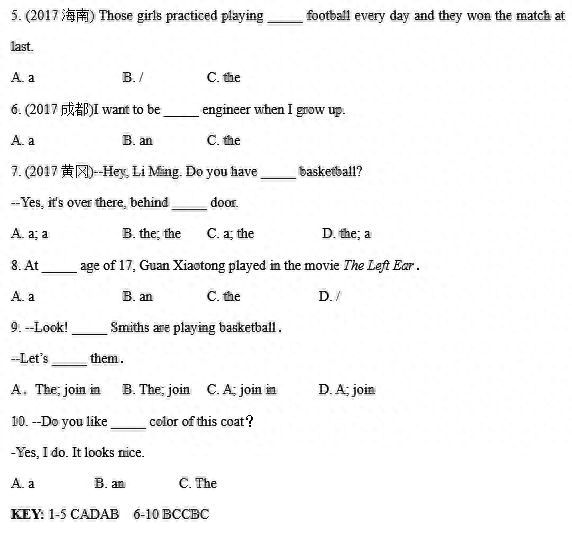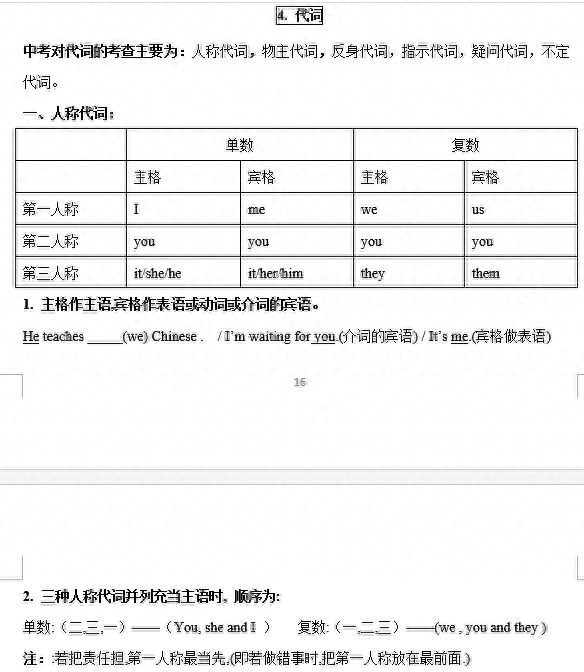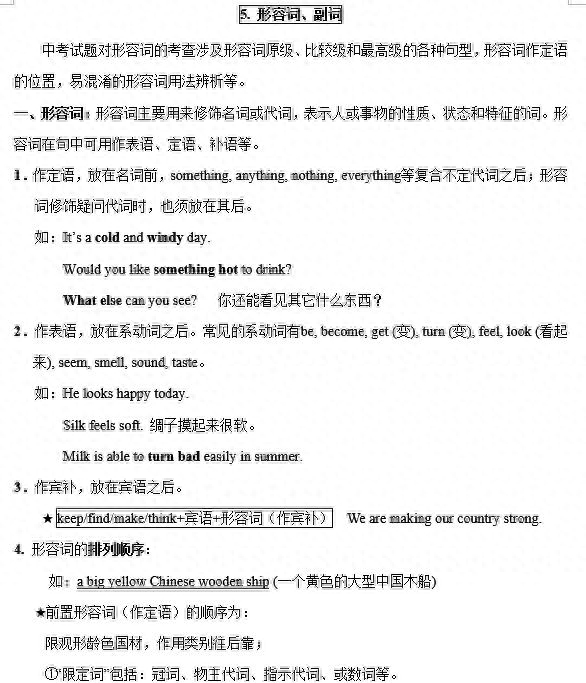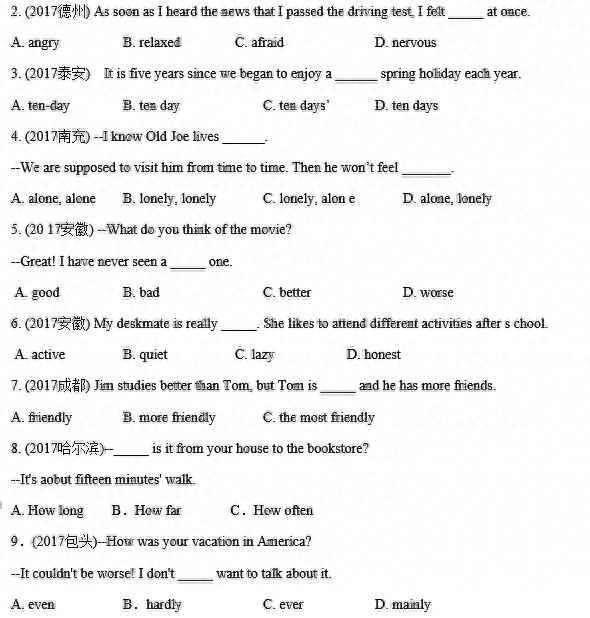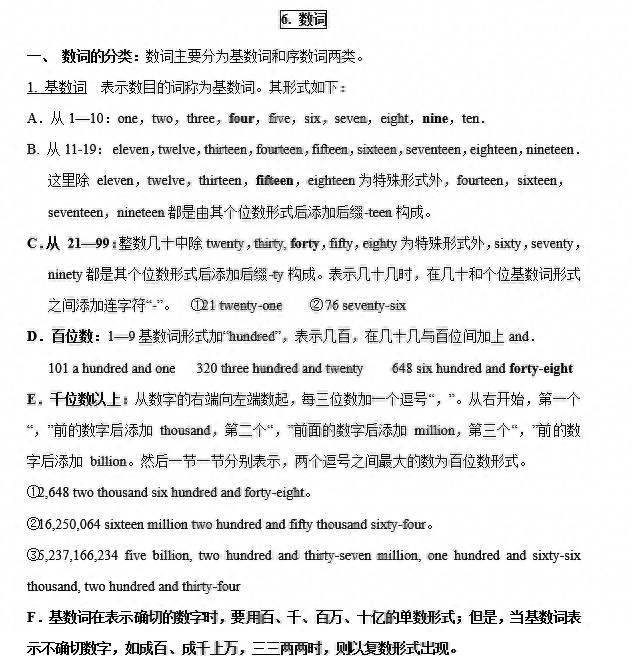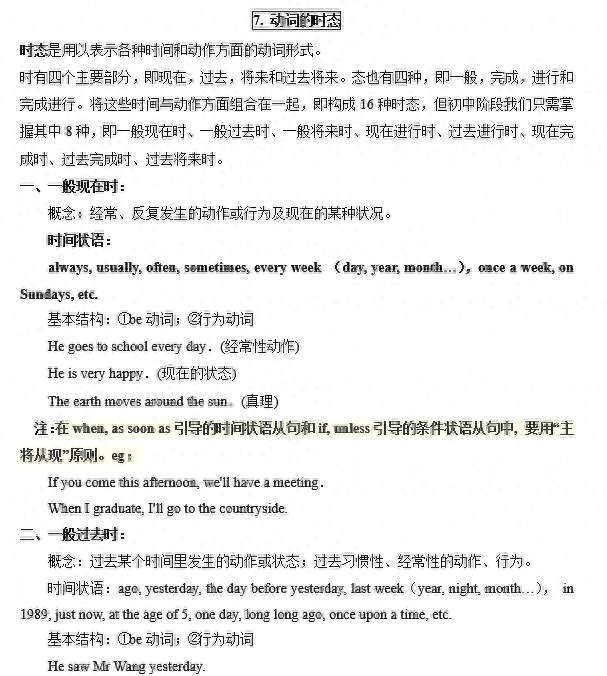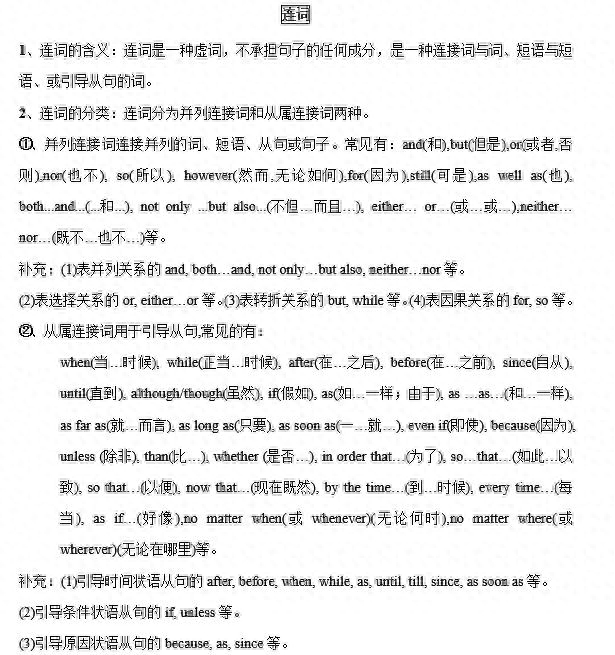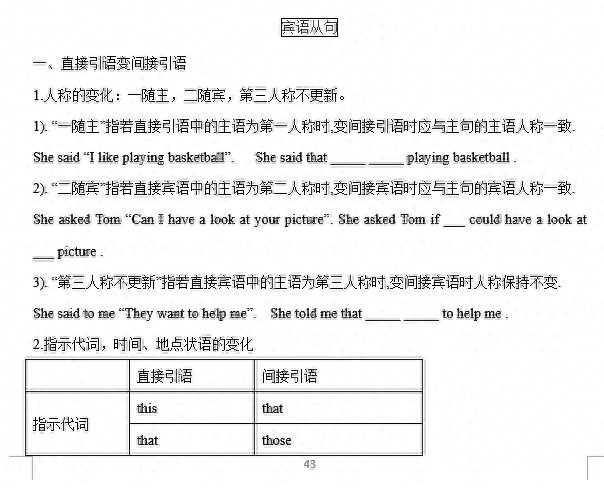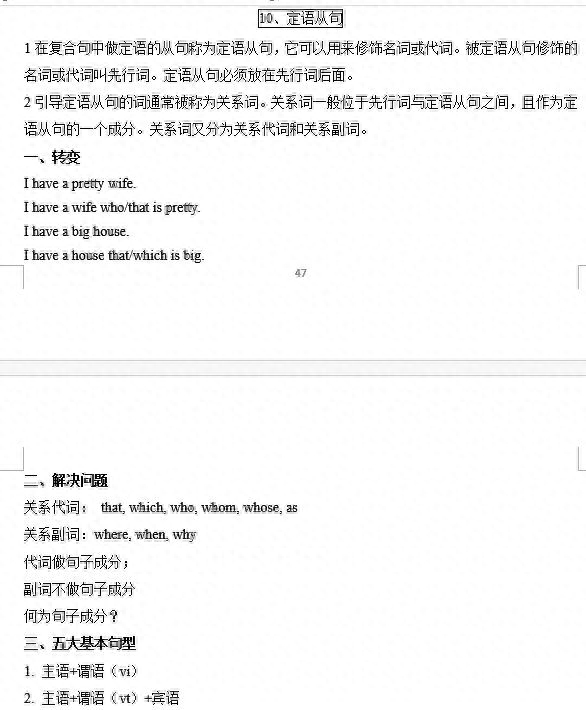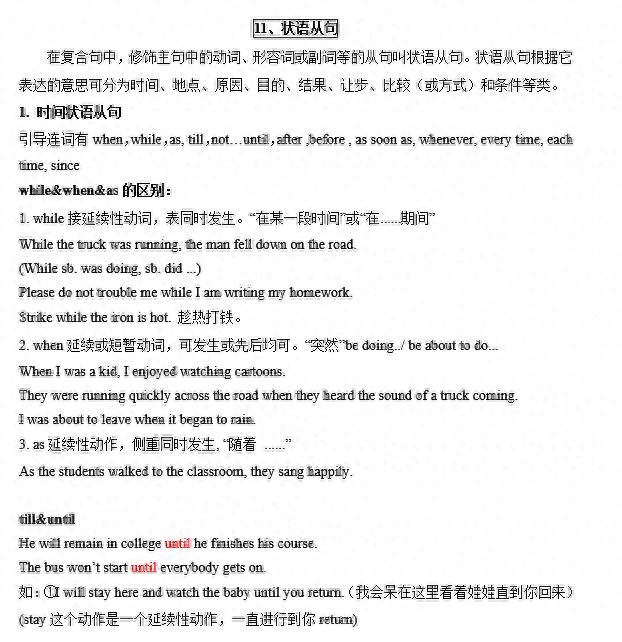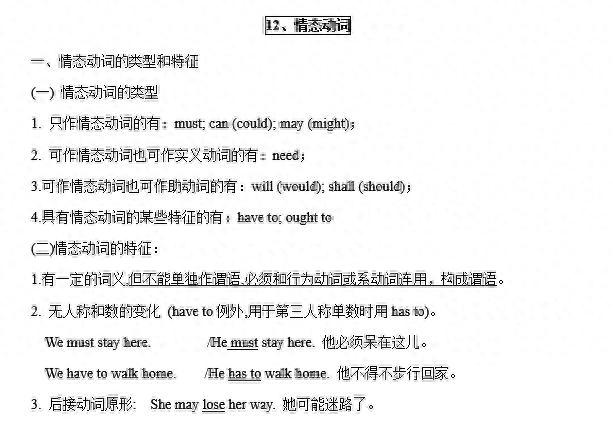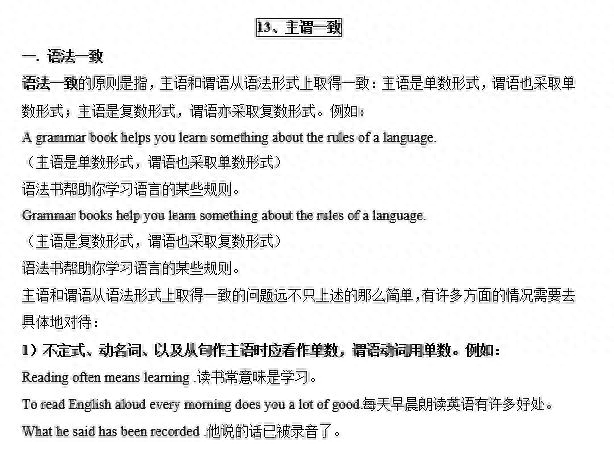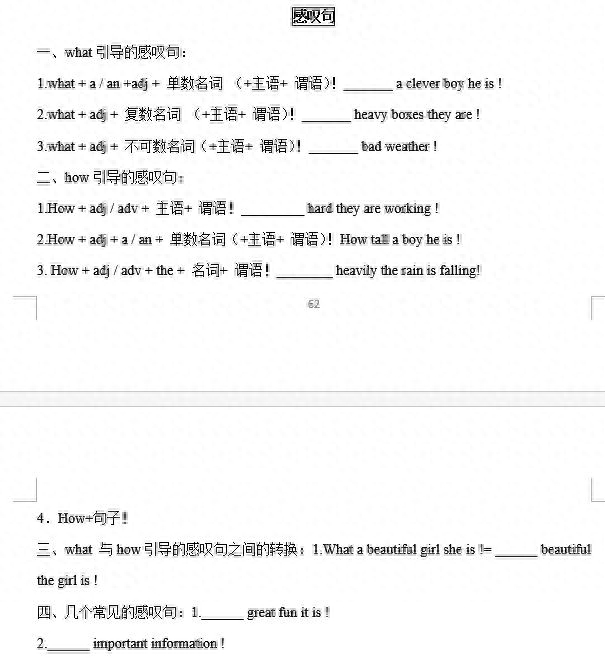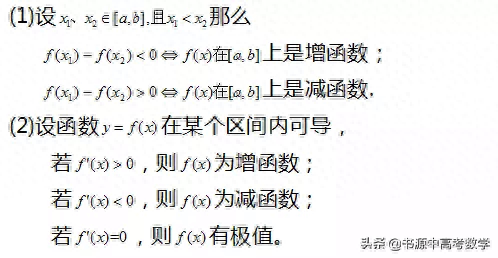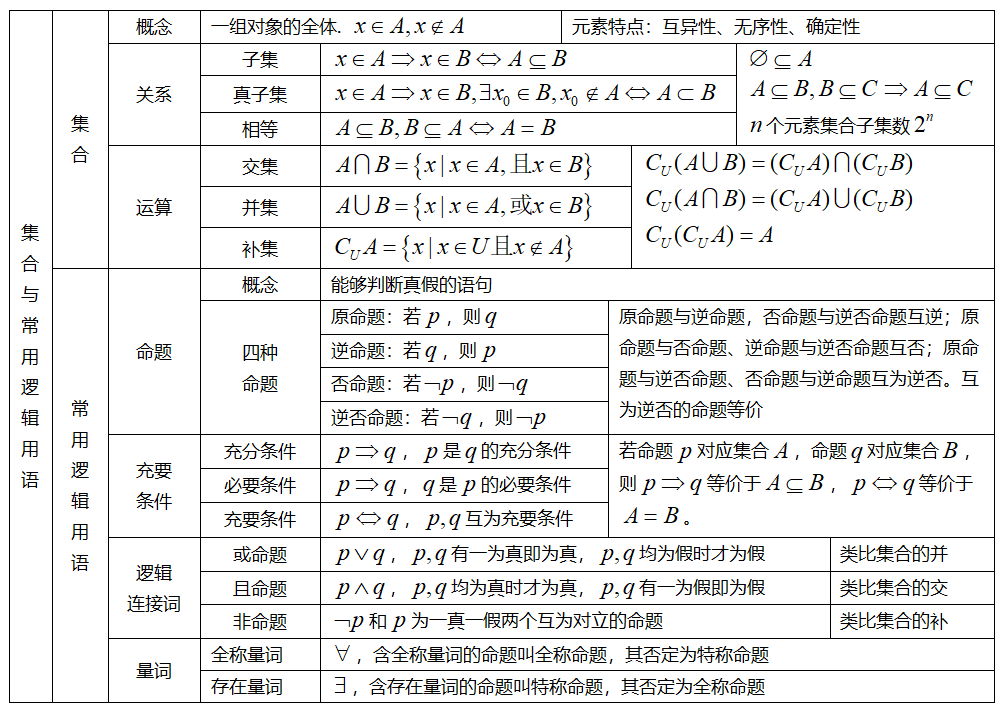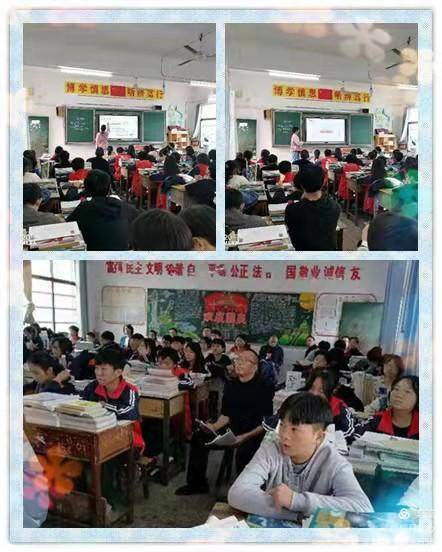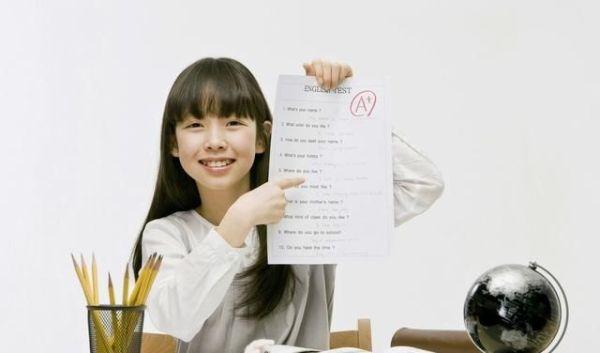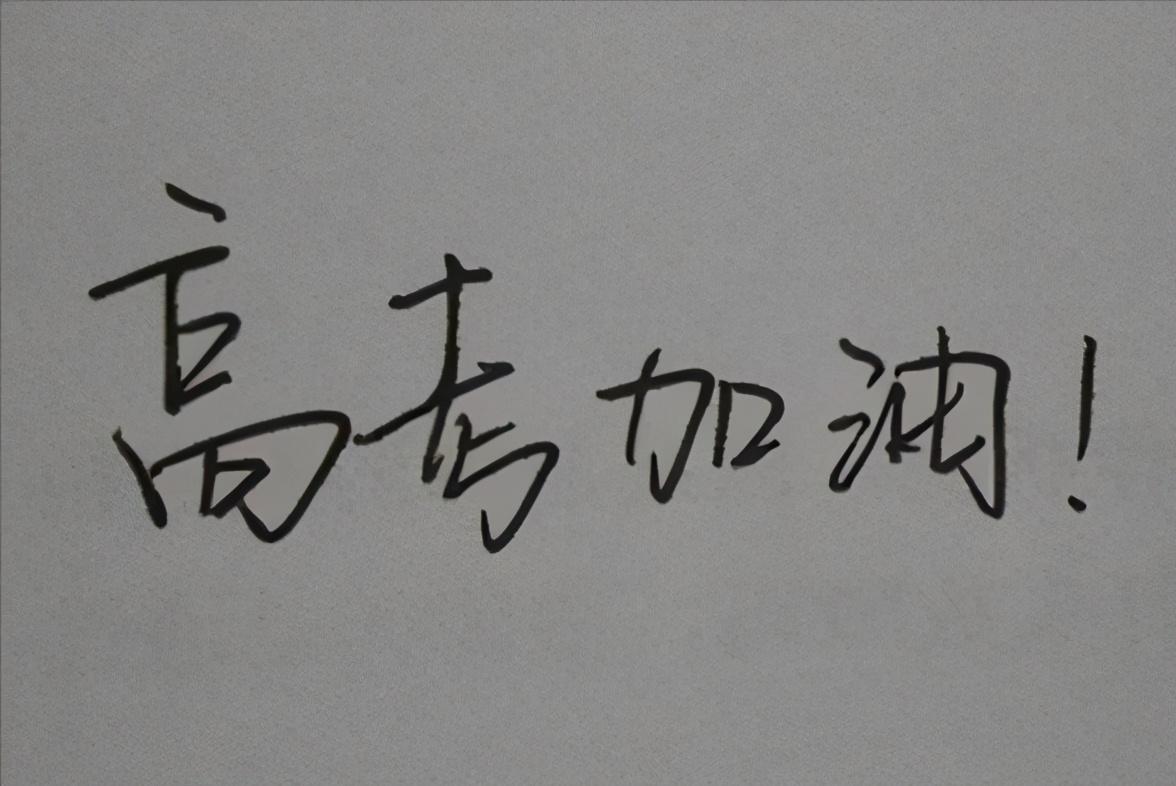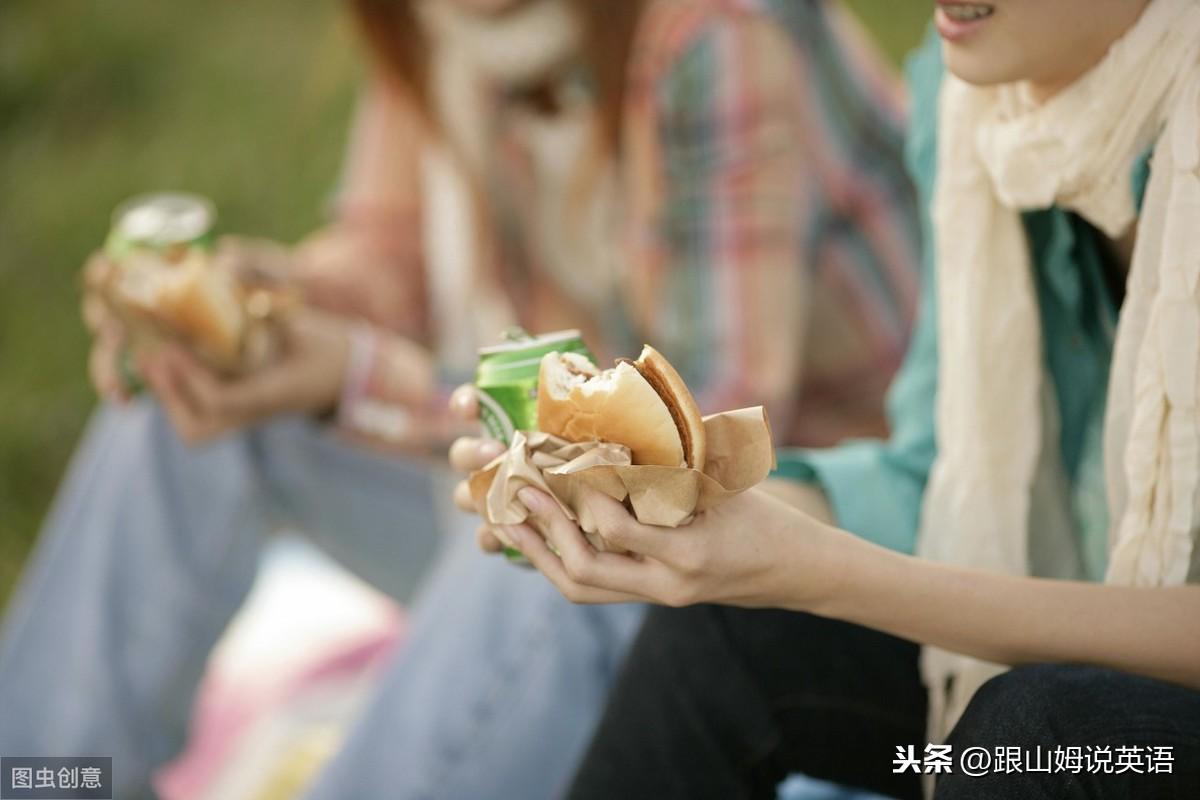
初中英语语法目录
1、名词
2、介词
3、冠词
4、代词
5、形容词、副词
6、数词
7、动词的时态
8、连词
9、宾语从句
10、定语从句
11、状语从句
12、情态动词
13、主谓一致
14、感叹句
欢迎订阅中考英语精品课,专栏包含3大题型专练+视频精讲,暑期助力新初三学生。
1. 名词
名词是中考考查的重点,考查内容主要为:
1. 名词单、复数的变化规律及其用法; 2. 不可数名词量的表达法;
3. 名词所有格的变化及其用法; 4. 名词作主语的一致问题;
5. 常用专有名词的表示法;
6. 具体语境中名词的词义和一些常用易混淆名词的区别。
一、名词的定义:表示人、事物或抽象概念的名称的词。
二、名词的分类:
名词可以分为专有名词(Proper Nouns)和普通名词 (Common Nouns),专有名词是某个(些)人,地方,机构等专有的名称,如Beijing,China等。普通名词是一类人或东西或是一个抽象概念的名词,如:book,sadness等。普通名词又可分为下面四类:
1)个体名词(Individual Nouns):表示某类人或东西中的个体,如:gun。
2)集体名词(Collective Nouns):表示若干个个体组成的集合体,如:family。
3)物质名词(Material Nouns):表示无法分为个体的实物,如:air。
4)抽象名词(Abstract Nouns):表示动作、状态、品质、感情等抽象概念,如:work。
三、名词的数
1). 可数名词有单数和复数两种形式:
1. 单数
英语中,如果我们要表示一本书、一只鸟、一棵树等概念时,要用名词的单数形式,表示名词的单数,要在名词前加冠词a或an。
This is a desk . 这是一张书桌。
There is an orange on the table. 桌上有一个橘子。
an orange 一个橘子
an new orange (×) → a new orange (○)一个新橘子
a desk
a old desk (×) → an old desk (○)一张旧课桌
a和an的使用区别
a加在以辅音开头的名词前,如a book,a pen。
an加在以元音开头的名词前,如an egg,an apple。
注意:
有时a,an后面紧接的不是单数名词,而是a (an) +形容词+单数名词的形式。这时判断用a还是an来表示“一个”的概念时,要看形容词开头字母的发音,而不是看名词。
2. 复数
英语中,如果要表示两本书、三个学生、四把椅子这些两个或两个以上的概念时,要用名词的复数形式,名词的复数形式是在单数名词后加上词尾-s或-es构成的。变复数时情况如下:
(1)一般情况下,在词尾加s.
eg: book—books, dog—dogs, pen—pens, boy—boys
以轻辅音结尾的名词后的s的读音为[s],以浊辅音和元音结尾名词后的s读音为〔z〕。
(2)以s, x, ch, sh结尾的词名词变复数时,要在词尾加es.
eg: beach—beaches, brush—brushes, bus—buses, box—boxes(es读音为〔iz〕)
(3)以“辅音字母+y”结尾的名词,先变y为i,再加es.
eg: city—cities,family—families,documentary—documentaries,country—countries,
strawberry——strawberries(ies读音为[iz])
(注:以“元音字母+y”结尾的词,直接在词尾加-s. eg: boys, holidays, days)
(4)以元音字母。结尾的名词,变复数时情况如下:
①加eg: tomato—tomatoes, potato—potatoes
②结尾是两个元音字母的加s,eg.zoo—zoos, radio——radios
③某些外来词变复数时词尾加s,eg. piano—pianos
④一些名词的缩写形式变复数时,词尾加s,
eg.photo(photograph)——photos, kilo(kilogram)kilos
⑤zero变复数时,既可加s,也可加es eg.zeros/zeroes
(5)以f或fe结尾的名词变复数时,先把f或fe变为v,再加es.
selves, lives, thieves, wives, knives, leaves, shelves, wolves, halves
(注意:roof的复数为roofs;belief-beliefs)
(6)有些名词由单数变复数时,不是在词尾加s或es,而是变换其中的字母。
eg. man—men, woman—women, policeman—policemen, Englishman—Englishmen, Frenchman—Frenchmen, foot—feet, tooth—teeth, child—children, mouse—mice, Ox—Oxen
请区别:German(德国人)—Germans, child—children
(7)还有一些名词的单数和复数形式相同。
eg. Chinese, Japanese, sheep, deer, fish
li,jin,yuan,two li,three mu,four jin
但除人民币元、角、分外,美元、英镑、法郎等都有复数形式。如:
a dollar, two dollars; a meter, two meters
注意: 这些词是可数名词,且单复数形式相同,所以可以写为:
This is a fish.
These are fish.
另外,fish作为鱼肉讲时是不可数的。
There is much fish on the plate.
(8)另一些名词本身即是复数形式,不可用作单数。
eg, people, police, trousers, pants, clothes, scissors
(9)以s结尾,仍为单数的名词,如:
a. maths,politics,physics等学科名词,为不可数名词,是单数。
b. news 是不可数名词。
c. the United States,the United Nations 应视为单数。
The United Nations was organized in 1945. 联合国是1945年组建起来的。
d. 以复数形式出现的书名,剧名,报纸,杂志名,也可视为单数。
"The Arabian Nights" is a very interesting story-book.
<<一千零一夜>>是一本非常有趣的故事书。
可修饰名词的常用词:
1) 修饰可数名词与不可数名词:some, any, a lot of, lots of, plenty of
2)修饰可数名词的有:many, (a)few, a large (great) number of
3)只修饰不可数名词的有:much, (a)little, a great deal of
四、名词的所有格(表示人或物的所属关系)
(1) 有生命的名词所有格以及表示时间、距离、城镇、国家等的名词所有格。
Beijing's street 北京的街道
today's newspaper 今天的报纸
ten minutes' walk 十分钟的路程
①不是以s结尾的名词变成所有格时,在词尾加's.
eg. Mike's watch;Women's Day
②以s结尾的名词变成所有格时,只加’。
eg. teachers' office, students' rooms
③两个或两个以上名词并列,表示共同所有,只需在最后一个名词后加's.
eg. Tom and Mike's room汤姆和迈克的房间(表示汤姆和迈克共有一间房)
④两个或两个以上名词并列,表示分别所有,需在几个名词后都加's.
eg. Mary's and Jenny's bikes玛丽和詹妮的自行车(表示玛丽和詹妮各自的自行车)
注意:
在某些句子里,名词所有格修饰的词,往往可以省略。
John's bike is better than Mike's . 约翰的自行车比迈克的好。
⑤.在表示店铺或教堂的名字或某人的家时,名词所有格的后面常常不出现它所修饰的名词,如:the barber's 理发店。
(2)无生命的事物的名词所有格常用of结构
eg: a map Of China, the beginning of this game, the door of the room
(3)特殊形式
①可用's和of短语表示的名词所有格
eg. the boy's name=the name Of the boy(男孩的名字)
the dog's legs=the legs of the dog(狗的腿)
China's population=the population Of China(中国的人口)
China's capital=the capital of China(中国的首都)
②双重所有格
eg: a fiend of my mother's我妈妈的一个朋友 a picture of Tom's汤姆的一张图片
③用所有格表示节日的方法: 如:Teachers' Day; Children's Day
(除了父亲节和母亲节其他节日我们都用名词复数的所有格表示。)
如:Mother's Day; Father's Day.
④由some、any、no、every与one、body 结合的复合不定代词something, anything等和else 连用时,所有格应加在else的后面。This is ________ (somebody else ) pencil .
中考再现:
1. (2017江西) —Do you have any _____ for tonight yet?
—Not yet. What about having a picnic on the beach?
A. problems B. news C. plans D. rules
2. (2017福建) —Nowadays more and more foreigners are becoming interested in Beijing Opera.
—That's true. It's an important part of Chinese _____.
A. culture B. invention C. custom D. tradition
3. (2017海南) It is very hot in Hainan this summer. On June 3rd, the _____ in Lingao reached 41.9℃.
A. temperature B. information C. development D. progress
4. (2017上海) Did the policeman give much _____ on how to protect personal information?
A. note B. tip C. advice D. book
5. (2017天津) Don't stand too close to North Americans. You'd better give them more personal _____ .
A. time B. system C. space D. pity
6. (2017重庆) —Judy, I will have a meeting in Canada next week.
—Well, you'd better take a _____ with you, or you may easily get lost.
A. photo B. stamp C. map D. postcard
7. (2017安徽) The New Silk Road will offer a good _____ for more nations to communicate.
A. chance B. habit C. question D. price
8. (2017山西) You should look into his eyes when you talk to somebody. It shows your _____.
A. shyness B. politeness C. quietness D. rudeness
9. (2017南京) —I go swimming every day.
—Wow! That's a good _____. It keeps you healthy.
A. match B. task C. habit D. dream
10. (2017武汉) —I wonder if you've made a decision on the project, Eric.
—Not yet. I can't make it until I have first-hand _____ on prices.
A. news B. knowledge C. information D. education
11. (2017哈尔滨) During the Spring Festival, people in Northern China usually eat _____ as a traditional Chinese food.
A. pizza B. dumplings C. hamburgers D. bread
12. (2017苏州)—Shall we go on Friday or Saturday?
—Either day is OK. It makes no _____ to me.
A. choice B. change C. difference D. decision
13. (2017孝感) Computers are very useful. They can help us get much _____ on the Internet.
A. games B. information C. courage D. messages
14. (2017青岛) Fruit is good for health, so I often have breakfast with one _____.
A. candy B. cake C. banana D. hamburger
15. (2017烟台) —It's dangerous to drive after drinking.
—That's true. It can increase the _____ of traffic accidents.
A. advantage B. stress C. safety D. risk
16. (2017达州) —Could you please offer me some _____ in my speech?
—Yes, sure.
A. idea B. message C. suggestion D. advice
17. (2017怀化) —It's hot today. Have some _____, please.
—No, thanks. I'm not thirsty at all.
A. water B. potatoes C. bread D. rice
18. (2017扬州) My grandpa knows the history and medical _____ of many plants.
A. wealth B. price C. value D. cost
19. (2017黄冈) —What's your prediction about the _____ of our school basketball match next week?
—I am sure Class 8 will be the winner.
A. teammate B. result C. information D. player
20. (2017襄阳) —What's your _____ to English learning, Lin Tao?
—I think watching English movies is helpful.
A. place B. age C. time D. secret
KEY: 1-5 CAACC 6-10 CABCC 11-15 BCBCD 16-20 DACBD

2. 介词
一、表示时间的介词
1. in, on, at 在……(之时)
①in与年、季节、月、年代、世纪及一般(泛指)的早、中、晚等较长时间的词连用
eg: in summer在夏天; in January在1月; in 2012 在2012年;
in the morning在早上; in the 21st century
②on用于具体的某日或某特定日期的早、中、晚。
如:on August 8th在8月8日; on Monday在星期一; on New Year's Day;
on a cold morning 在一个寒冷的早晨;on Sunday afternoon在星期天下午。
③at表示某一时刻。
如:at 5: 10 pm; at the beginning of;at the end of...;at the age of...;
at noon;at the same time; at night;
2. in, after 在……之后
“in+时间段”用于将来时之中;“after+时间段”用于过去时态之中;“after+时间点”既可用于将来时也可用于过去时。
如: Jim will go to Beijing in five days. 吉姆五天后会去北京。
Jim went to Beijing after five days. 五天后,吉姆去了北京。
Jim will go to Beijing after five o'clock. 吉姆会在五点钟后去北京。
3. for, since
for可以指过去、现在或将来,着重说明“多久”, 后面接时间段。since意为“自从……起”,多与完成时连用,后面接时间点或从句。since引导的从句通常为一般过去时。如:
He has lived here for 2 weeks.
He has lived here since 2 weeks ago.
It's five years since he left school.
4. after, behind 在……之后
after主要用于表示时间;behind主要用于表示位置。
如:You should take a walk after dinner. /The picture is behind the door.
二、表示地理位置的介词
1. in, on, to
1).in表示A地在B地范围之内.(包含关系)
2).on表示A,B地接壤.(外切关系)
3).to表示A,B两地有一定的间距.(外离关系)
Hubei is ___ the north of Hunan.
Tanwan is ___ the southeast of China.
Japan is ___ the east of China.
2. at, in, on
1) at 接小地点或较具体的位置”。at home / at the station
如:He arrived at school at 8 o'clock. 他8点钟到学校
2) in 接在大地点 in China; in the world ; He arrived in Wenzhou yesterday.
3) on 表在一个平面上 on the farm
3. above, over, on 在……上
①above 指在……上方,表相对高度,不强调是否垂直,与below相对;
The bird is flying above my head. 鸟在我的头上飞。
②over指在……正上方,表垂直的高度,与under相对;
There is a bridge over the river. 河上有一座桥。
③on表示某物体上面并与之接触,与beneath相对。
There is a book on the desk.
4. below, under 在……下面;under表示“在……正下方”;below表示“在……下,不一定在正下方”。如:
There is a dog under the desk. / Please write your name below the line.
5. in front of / in the front of
in the front of 表示在…….内部的前面 ;in front of 表示在……外面的前面
There is a desk in _____ front of our classroom .
There is a big tree in _____ front of our classroom.
中考再现:
时间介词和方式介词
1. (2017·北京)More and more young people go skating _____ Winter.
A. at B. in C. on D. to
2. (2016·宿迁)The 2016 Summer Youth Olympic Games will be held_______ August in Nanjing.
A. in B. on C. by D. at
3. (2016·来宾)—When is Jay’s concert?
—It’s ______three o’clock______ the afternoon.
A. at; in B. at; on C. in; in D. on; in
4. (2016·南充)—When were you born?
—I was born______ a cold winter morning in 1994.
A. in B. at C. on D. of
5. (2017·长沙) _____ April 22nd, people around the world celebrate Earth Day in different ways.
A. In B. At C. On
方位介词
6. (2017·上海) Shirley is still waiting for her flight to New York City _____ the airport.
A. at B. under C. on D. with
7. (2017·安徽)To my pleasure, my family is always _____ me whatever I decide to do.
A. above B. behind C. from D. through
8. (2016·益阳)Uncle Tom lives ______ a farm _____ the country.
A. in; at B. near; on C. on; in
9. (2016·天津)Cambridge is a small city______ the east of England.
A. between B. with C. in D. under
10. (2017·恩施)--Taiwan is an important part of China.
--Yes, it lies _____ the southeast of China.
A. in B. on C. to
其他介词
11. (2017·河南)--Do you know the student _____ David and Jack?
--Yeah. It's Jim.
A. among B. in C. between D. around
12. (2016·铜仁)—How can we protect ourselves _____ the earthquake?
—We should stay calm first.
A. with B. about C. for D. from
13. (2016·苏州)The castle stands in a quiet place _____ the main road at the far end of the river.
A. to B. for C. off D. out
14. (2016·连云港)—A person’s life is like a road ____ lots of difficulties.
—Yes,so we need positive energy.
A. by B. with C. along D. during
15. (2016·无锡)I hope the train will arrive on time,but it’s _____ my control.
A. within B. without C. under D. beyond
16. (2016·杭州)They usually go shopping ____ their lunch break.
A. against B. among C. between D. during
17. (2016·潍坊)—What can I do for you?
—I hope I have a nice house ______ a big garden.
A. of B. with C. form D. about
18. (2016·盐城)Many cities in China,_____ Beijing,have been deeply affected by dirty air.
A. including B. behind C. without D. beyond
19. (2016·莱芜)We can save money ______ cooking our own meals instead of eating outside.
A. by B. to C. for D. with
20. (2017·孝感)—Reading is a good way to spend the time on the plane.
—That's true. I never go travelling _____ a book.
A. without B. from C. on D. about
KEY:1-5 BAACC 6-10 ABCCA 11-15 CDCBD 16-20 DBAAA
